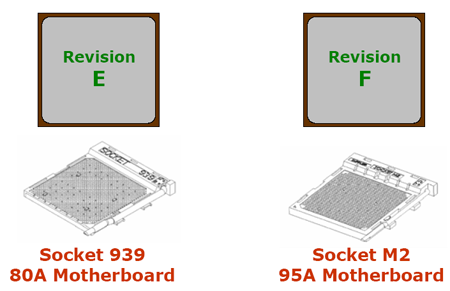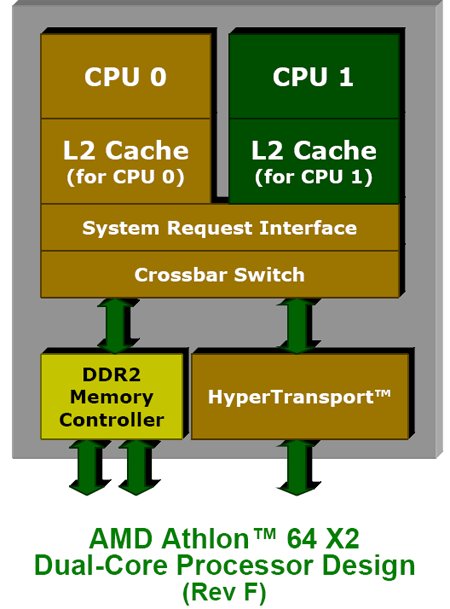Q3'05 AMD Roadmap; DDR2 and New Sockets for AMD
by Kristopher Kubicki & Jarred Walton on July 21, 2005 1:47 PM EST- Posted in
- CPUs
AMD CPU Roadmap Update
We haven't updated our AMD roadmap for a few months, in part due to overlapping NDAs and product launches. Unfortunately we are just about to go under NDA for AMD's next low clock X2 processor - but rather than postpone another roadmap we decided to carry on just without that information. Our last detailed AMD roadmap was actually back in December, and we have quite a bit of new information to cover. We'll focus primarily on the upcoming parts, which will be highlighted in red in our tables, but we'll also list details on many of the currently shipping parts. Let's start with the desktop sector.
Introducing M2
The big news of course is the upcoming transition from socket 939 to socket M2. M2 will have 940 pins, and while the actual layout of motherboards with the new socket will be very similar to socket 939, processors will obviously not be pin compatible. The same goes for current socket 940 processors: they won't work or fit in socket M2. That makes sense, considering that M2 will require the use of DDR2 memory. The similarity in layout will allow motherboard makers to quickly adapt 939 designs to M2, however.
Initially slated to support up to DDR2-667, the socket M2 processors will launch in the second quarter of 2006. Codenamed Orleans for the single core processors, the roadmaps include few details on the clock speeds or cache amounts of the new parts. Without speculating too much, we would assume that the specifications will be the same as equivalent 939 processors, but we could be wrong. Another possibility is that the DDR2 parts will outperform the socket 939 parts, allowing AMD to modify their names (again). Either option seems equally likely, and we wouldn't be surprised to see the 4000+ M2 ship as a 2.6 GHz 512K part, as that would allow the use of a single design for the three listed chips.

Processors running on the new M2 socket are dubbed Revision "F". Revision "F" processors carry all the features of existing "E" CPUs, but along with the new socket comes some significant changes in power. For example, a typical Revision "E" San Diego Athlon 64 utilizes 80 amps with a maximum TDP around 90W. The new Revision "F" CPUs will use 95 amps instead. However, although the processors require a bump in the current, the power remains the same. Unfortunately, expect massive increases in TDP. From the roadmap we expect the FX M2 processors to have a max TDP of 125W, 110W for dual core and 104W for single core. Revision "F" implements a new Bi-Directional PROCHOT so that the motherboard can throttle the processor dynamically, but the CPU can also override and throttle itself if necessary.

The main changes to the processor diagram only appear to be the integrated DDR2 controller instead of the integrated DDR1 controller.










51 Comments
View All Comments
Zebo - Tuesday, July 26, 2005 - link
Hehe I hear ya this new format is confusing to say the least.. I much prefered the "flat" version. :)Anyway isolating CPU power today is faily trivial to do since all modern CPU's are fed by the 12V 4 or 8 pin dedicated auxiliary power connector. For specfic methodology please look here: http://www.lostcircuits.com/cpu/amd_venice/5.shtml">http://www.lostcircuits.com/cpu/amd_venice/5.shtml
JarredWalton - Saturday, August 6, 2005 - link
SO the 4-pin ATX12V is *only* for the CPU and the CPU doesn't draw power from anything else? Damn, learn something new each day! I guess a clamp around the two +12V lines would be able to measure the current with moderate accuracy.KristopherKubicki - Sunday, July 24, 2005 - link
Zebo: We have one coming up... And yes; Turion can't compare to Pentium M per watt.Pentium M isn't worthwhile outside of mobility; and no one argues it's an awesome mobility chip. Turion is nice, but AMD has an incredibly long way to go to catch up in the mobile sector. Expect an AnandTech review in the near future, although it's going to have a desktop focus.
Kristopher
Zebo - Sunday, July 24, 2005 - link
"AMD has been trailing in the mobile performance per Watt competition ever since Intel launched the Pentium M. "How do you know? You refuse to do a turion notbook review. Actually it's been 6 months since you've done a moblie review what's up with that? I sent anand an email, never heard back from him.
Anyway lets look at someone who HAS done the legwork;) :P Albeit not anandtech high quality standards.. just a few synthetics and batt life similarly equiped.
http://asia.cnet.com/reviews/hardware/notebooks/0,...
I know Intel fans think the Pentium M is the second coming of christ but the numbers simply don't bear that out.. Turion, at least in acer form, is very competitive performance and battery wise with the Pentium M, indescerable really, and it's usually cheaper.
Like this sweet little MSI jobber... Purdy and only $700
http://www.hardwarezone.com/articles/print.php?cid...
.. it's about time for Anandtech to clear up the noise with a real review don't you think?....
JarredWalton - Saturday, July 23, 2005 - link
20 - The current is reported from the AMD specs listed in the roadmap. While there will certainly be parts that run at lower power output than the maximum we've listed, the highest performing parts will likely approach those values.Maybe someone with a better knowledge of electronics can verify this, but just because the socket can supply 80 Amps on current 939 boards doesn't mean the CPU has to use all 80 Amps, right? It's like a water pipe going to the house: it might provide enough water pressure to run all the sinks at once, but the individual sink may never use that much water.
Anyway, 80 A * 1.4V = 112W. Revision E 939 is as follows: X2 chips have a TDP of 110W, meaning they can use everything the socket provides. FX-939 can use 104W, and the single core chips are 89W. Revision C/D used higher voltages but lower Amps and had FX-55 at 104W, FX-53 and other single cores as 89W. 60A * 1.7V = 102W, roughly the value listed for FX-55. The 1.5V chips were 90W in comparison.
Finally, we have M2 parts slated to use 95A. 95A * 1.3V = 123.5W, indicating that the FX will use all the Amps available. X2 will remain at 110W, so it will either use less of the available Amperage or else it will run at lower voltages. Single core will be 104W, slightly lower than X2. These are all maximums, however, so the mid-range parts probably won't be any worse than current parts; it's AMD building for future parts - they have to make sure that all motherboards can supply the power required by the top chips.
Jeff7181 - Monday, July 25, 2005 - link
Thanks for the response Jarred. Your response is accurate, but that doesn't explain this quote from the article.That's impossible unless the revision E San Diego's run on 1.125 volts. I understand 80A and 90W are "worst case scenario's." Still, it can't have a maximum amperage of 80 AND a maximum wattage of 90 because that means the voltage will NEVER be over 1.125 volts.
aldamon - Saturday, July 23, 2005 - link
With regards to your comments on the Newark 4000+:"As virtually any socket 754 board should have no trouble supporting these mobile variants, 754 owners looking to upgrade for additional CPU performance might be interested in checking out these parts."
My 8KDA3J won't support Newarks and as far as I can tell it's just a BIOS limitation. The 8KDA3+ is in the same predicament. It would be nice if Epox would make a effort to support ALL 754 CPUs for our older S754 boards. They're being stubborn so far.
PrinceGaz - Saturday, July 23, 2005 - link
#19 Jarred- you make some good points on whether the 4400+ is really a better buy than the 4200+. Yes I do intend to overclock as I'll be pairing whichever I go for up with a DFI mobo, and a Thermalright XP-90C heatsink (and suitable fan) which I've heard is one of the best coolers, and seeing what I can get out of it.The upcoming 3800+ is tempting as it should be a good bit cheaper, but I'm concerned that what they'll be are all the speed-binned rejects of both the Manchester and Toledo cored X2's that had very little headroom. The Toledo parts would have half the cache disabled of course, providing a further means for AMD to offload rejects with a fault in part of the cache (similar to what they did with .
I think I'll wait and see rather than possibly spend a small fortune on a 4400+ that overclocks no better than a part little more than half the price. Another month hardly matters as I'm not desperate, but it does seem a bit of a waste running my two new 1GB PC3200 CAS2 sticks on an old KT266A mobo at 138 FSB :)
Jeff7181 - Saturday, July 23, 2005 - link
Kristopher Kubicki & Jarred Walton... could you explain something to me?Watts = volts x amps
90 watt CPU running on 1.4 volts = 65 amps (90/1.4=~65)... how'd you get 80?????
JarredWalton - Friday, July 22, 2005 - link
13 - PrinceGaz, I realize that having more cache can be helpful, but in general is the $100 price increase worth the extra 4% performance for the X2 4400+? More importantly (if you're willing to overclock), it's probably $250 more than the X2 CPU that was mentioned above. and still only slightly faster. If I could get my hands on them, I'd like to try overclocking the 4200+ and 4400+. My instinct tells me the extra cache may reduce overclocking headroom a bit, making the two basically equal in performance.18 - I don't think DDR1 will dry up that quickly, so Q2'06 seems reasonable for DDR2. The 65nm parts from Intel are going to be the interesting competition. Pressler/Cedar Mill aren't too special, but Conroe/Merom could present a tought matchup for K8+DDR2. Unless K9 is coming out sooner rather than later, the new architecture from Intel may regain the performance crown for a while. Still, competition is good for us, so whatever happens happens. 200 MHz per quarter is going to be unlikely for a while, though. Some are saying we'll stay in the 2 to 4 GHz range for many many years and just add more cores.
As for DDR2/3 and FB-DIMM, while the base technology may be similar, I'd be surprised if the DIMMs are interchangeable. FB-DIMM is really targeting servers/workstations, where the current 2 DIMM per channel maximum memory is extremely limiting. It won't be quite as fast, but it should allow for 4 DIMMs per channel at least, and possibly more (?). Like registered vs. unbuffered DIMMs, the boards/chipsets/CPUs will either require FB-DIMM or not support it at all I think.